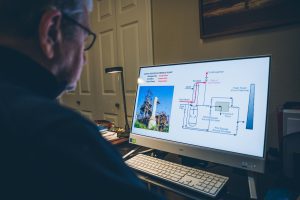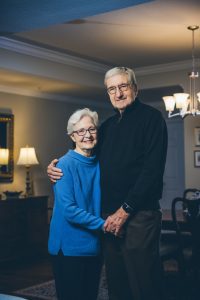Growing up in Lonoke, Jerry Havens often went camping alone. He’d walk two blocks to the railroad tracks, then follow the tracks five miles to a bayou, where he slept amidst nature. For breakfast, he cooked eggs. “I can still feel the dew when I’d wake up in the morning.”
About 2,000 people lived in his hometown, located 30 miles east of Little Rock in rice country. His dad went through eighth grade in school, and his mom completed two years of junior college after high school. She ran a small grocery store adjacent to their home in the middle of town.
Jerry is 14 and seven years older than his two brothers, so he spent much time on his own – hunting, fishing, camping and thinking. Today, he often reflects on developments in his life, how if certain things hadn’t happened, particularly in connection to a couple of people, “my life would have been totally different.”
One of those was a high school teacher who took an interest in him and noted certain strengths, such as math. The teacher suggested Jerry become an engineer. That idea stuck and eventually set him on a path toward a career in chemical engineering. Now an Emeritus Distinguished Professor, he taught at the University of Arkansas for more than 40 years, and he’s served as a consultant to dozens of U.S. and international government agencies and industries.
Jerry would come to specialize in two main areas: atmospheric dispersion of hazardous gases and aerosols and fire/explosion phenomena. He’s written 50 to 60 peer reviewed papers and presented his work around the world. A paper he considers one of his best focuses on the atmospheric dispersion that resulted from the 1984 chemical spill at a pesticide plant in Bhopal, India, then a city of 1 million people, which he’s visited several times.
Ten years after the incident, he helped a team of doctors understand the areas most affected so they could study how people were impacted. Now, at age 84, he’s still investigating, writing and presenting on the topic.

THE DRAW OF CHEMICAL ENGINEERING
For his first year of college, Jerry received a scholarship at Arkansas Tech University, where he entered the pre-engineering program. On a visit home, he heard that his dentist’s son was studying chemical engineering at the University of Arkansas. Jerry liked that it was among the most challenging of engineering fields, so he decided to scope out the Fayetteville campus himself. When he wandered into the chemical engineering department, the department head was the only person there, and they spent hours talking about the program.
Jerry was hooked. He transferred to the U of A his sophomore year and graduated with a bachelor’s degree in chemical engineering in 1961. He’d been in ROTC during college and graduated with a commission as second lieutenant. Next, he went to the University of Colorado at Boulder, which offered him a good fellowship, for his master’s degree in chemical engineering.
Before he went in the Army, they let him take a job at Procter & Gamble in Cincinnati, Ohio, where he worked for a year. When the Army called, they sent him to Columbus, Ga. Near the end of his training, they noticed he was a chemical engineer. He’d had some medical problems, so — while the rest of the class went to Vietnam — he was assigned to the arsenal in Pine Bluff, just 30 miles from his hometown, which produced smoke grenades and chemical weapons.
Jerry returned to Procter & Gamble for a year, but decided he didn’t want to stay in the chemical industry. Though his family didn’t want him to give up a good job, he applied and was accepted to the medical school program at University of Arkansas for Medical Sciences.
But he never got there. While in the technical library at Procter & Gamble, he saw an ad in Chemical Engineering magazine for graduate students at the University of Oklahoma. A professor there was researching a topic of interest to Jerry: the automatic control of processes.
So, westward he returned. Three weeks before he was scheduled to start medical school, Jerry drove to Norman, Okla., and met with Cedomir Sliepcevich, a Distinguished Professor, who offered him a fellowship. Jerry focused on the automatic control of processes for a year with another faculty member, but then switched to fire and explosion phenomena so he could work directly with Sliepcevich. “That’s where my career started.”
When Jerry finished his doctorate in 1969, he had to decide whether to stay in Norman or leave to pursue a career. He wasn’t sure of his next path. Then he got a call from the U of A offering him a position in 1970.

FINDING A FOCUS FOR RESEARCH
In his early years at the U of A, Jerry knew of only a few experts in fire and explosion phenomena, and none were chemical engineers. “It was coming into being though, because the chemical industry was expanding, and they were having big accidents and explosions.”
On sabbatical in his seventh year, Jerry served as technical advisor to the Office of Merchant Marine Safety for the U.S. Coast Guard in Washington, D.C. The Coast Guard regulated the carriage of hazardous materials by water, including “drug store tankers” – ships carrying as many as 40 or 50 different chemicals in segmented compartments. They asked him to look at the chemical formulas for each chemical and determine how to manage those cargos – creating guidelines of which chemical was unsafe to put next to another chemical in case the compartments leaked.
But his attention soon shifted to another issue: liquefied natural gas, or LNG. Liquefying natural gas allows it to be transported from its source location to those using it. In the late 1970s, there were five import terminals on the East Coast for some of biggest ships afloat loaded with LNG coming from the Middle East. There were concerns about the terminal locations becoming targets or an explosion happening.
Using mathematical models, Jerry calculated the degree of hazards these terminals posed — the potential size of an explosion, how far away someone could be burned or injured — and determine buffer zones. He wrote a report that was sent all over the world and is still on the internet. His work rebuffed the calculations being made then. He narrowed the danger zone down to less than ten miles and a minimum of two to three miles. He returned to Fayetteville and continued to work on LNG.
Jerry and his students at the U of A developed mathematical models for the atmospheric dispersion of toxic and flammable materials. In the case of a big spill that forms a cloud and moves downwind, these calculations help determine how far away the materials can still be dangerous. They wrote the first dispersion model for the regulatory federal agency, Pipeline and Hazardous Materials Safety Administration (PHMSA), which is still in use.
They also studied it through physical modeling, using an 80-foot-long wind tunnel built inside a former factory turned research center. Jerry was director of the Chemical Hazards Research Center from 1980 to 2013, when he returned to primarily teaching.
A main focus for Jerry has been the 1984 explosion at the pesticide plant in Bophal, India, considered, then and still, the world’s worst chemical accident. A plant operator who was there the night of accident gave Jerry a report that became the key to understanding the chemical reactions that occurred, causing about 40 tons to be spilled in the middle of the city. It also helped him analyze the composition of the chemicals in the resulting cloud that moved downwind.
He considers his paper on Bophal significant because it offers “mathematical predictions of what we think was a good explanation of how far and in what quantities this material spread out over the city.”
Jerry also was brought in as the principal expert on fire hazards for the federal investigation into the fire that destroyed the Branch Davidian Complex near Waco, Texas, in 1993. He and an associate used mathematical models to determine if the tear gas the military used could have started the fire and/or accelerated its spread. Factoring multiple building dimensions, with wind speeds and directions, they calculated the highest concentrations of tear gas in each room. And they determined that the fireball was caused by a propane tank in the kitchen.
Though many people were interested in the cult aspect of this well-known incident, Jerry’s work on it was very clear. “It was just science, and I didn’t have to do any judgmental things.” The toxicologists used his research to consider how the tear gas — typically used for riot control outside, where it can disperse — impacted the people inside the building. The concentrations were lethal.
LIFE AFTER RETIREMENT
 In 2017, Jerry and Carolyn Krodell married, and they live in a Village Home. He’s more of a recluse — preferring to stay home to read and study — while she’s more involved. They enjoy traveling, including trips to England on the Queen Mary II, and have seen The Phantom of the Opera in London three times. He enjoys his morning coffee and exercises three times a week at the fitness center. His son lives in Bella Vista, and his daughter lives in Ga., where she teaches biology at South Georgia State College.
In 2017, Jerry and Carolyn Krodell married, and they live in a Village Home. He’s more of a recluse — preferring to stay home to read and study — while she’s more involved. They enjoy traveling, including trips to England on the Queen Mary II, and have seen The Phantom of the Opera in London three times. He enjoys his morning coffee and exercises three times a week at the fitness center. His son lives in Bella Vista, and his daughter lives in Ga., where she teaches biology at South Georgia State College.
And Jerry is still researching and writing about liquefied natural gas, including a piece about the risk of vapor cloud explosions that he sent to federal regulators in early 2024. The United States is now the biggest exporter of LNG, much of that connected to fracking. Natural gas must be cooled by 200 degrees in order to liquefy it for storage or transport, and that process requires refrigerants that use heavy hydrocarbons, which are explosive. Federal regulations still haven’t been rewritten to address this hazard.
The BTV library has a copy of Thin Safety Margin, a book he recently co-authored on the water-cooled, plutonium-fueled SEFOR reactor, which conducted explosion safety experiments in the 1960s near Fayetteville.
As a benefit to his life of research, Jerry noted that one of his strengths is the ability to concentrate on things, almost to the exclusion of everything around him. “I do a lot of work with difficult thinking, so I’ve learned to not let anything interrupt me.”
Words by Michelle Parks | Photos by Stephen Ironside
